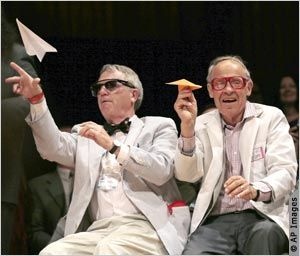
What scientific recognition they get for their work on the dynamics of coffee in a cup in motion, watching ostrich courting humans or a study to determine if a sigh is perhaps nothing more than a single sigh? Since 1991, a handful of researchers, working mainly in the fields of science, technology and medicine, are awarded each year the Ig Nobel Prizes for work of this kind.The Ig Nobel Prizes - not to be confused with the prestigious Nobel Prize - honoring the achievements that first make people smile before they are thinking. "The first time you hear about one of these jobs, you find it funny. But a week later, you realize that you are still stuck in your head, "says Marc Abrahams, editor of the humorous science magazine Annals of Improbable Research (Annals of Improbable Research) and co-founder of the ceremony awards .Each fall, the Ig Nobel award ceremony held in Sanders Theatre at Harvard University in Cambridge, Massachusetts, on the stage which are mounted once Winston Churchill, Theodore Roosevelt and Martin Luther King. The event is packed in this theater of 1,166 seats."This is a big patch of humanity, says Abrahams, bringing together all kinds of people who could not imagine meet in other circumstances. "Some members of the public have to cross the green campus of Harvard University to get there while others came from abroad, had to travel by plane. Some follow a scientific career, others have never set foot in a laboratory. Most participants provide with paper to make small aircraft, as tradition dictates, will be launched during the ceremony.But behind the humor lies a more serious cause. This bra transformed into protective mask, awarded at the 2009 ceremony? This is Elena Bodnar, specialist in electrical trauma, who invented it after he started his medical training in Ukraine where she participated in the evacuation and treatment of children during the Chernobyl nuclear disaster. Hundreds of thousands, workers breathed radioactive particles that plant. Masks designed by Ms. Bodnar can limit the inhalation of harmful particles suspended in the air.In 2006, the Dutch biologist Bart Knols and his colleague Ruurd de Jong received Ig Nobel prize for showing that the female mosquito Anopheles gambiae is also strongly attracted by the strong smell of Limburger cheese by the human feet. If the olfactory preferences of this insect may seem very trivial, this information has developed a revolutionary pill. By killing the mosquito to contact the person who ingested, the tablet allows the reduction of the incidence of malaria.
Mr. Knols is part of a handful of Ig Nobel Prize winners who also received a Nobel Prize. "The Ig Nobel Prize was not my only reward, but this is the one I'm most proud of because the award honors researchers who work outside the box," he has said.
Topping the list of winners of the Ig Nobel Prizes, five continents are generally well represented each year. However, Mr Abrahams noted that England and Japan are the most awarded country because according to him, "People are proud to rub eccentric. They develop ideas that seem strange and spend much of their lives to see where these ideas will lead. “
The objective of the Ig Nobel Prizes is precisely to encourage the willingness to explore aspects of life that may seem futile. Knols says, too often "scientific work no longer has this dimension that transforms and the results are too predictable." It offers scientists the challenge and encourages them to "do something that seems strange to others or unusual.”
Bart Knols, arm in a box mosquitoes (Florence Leeuwenberg)Over time, the ceremony Ig Nobel Prizes met an increasing success among the public. Some Nobel laureates have even joined the noisy public attending this event. Like the physicist Roy Glauber - Nobel Prize for his contribution to the quantum theory - who participated in the festivities over the past 15 years, armed with a broom to pick up the aircraft on the scene.
At the announcement of the Ig Nobel prize, the winner made his entrance on stage and shakes hands with a Nobel Prize: handshake representing the range of possibilities. "It's like the meeting of two opposite worlds that would look in the eyes," said Abrahams.



